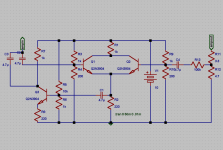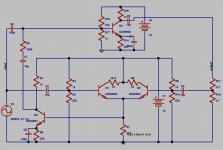As always, I was looking at another thread and an idea came to me spontaneously and an explosion of thought erupted in my brain! I thought that if you used an LTP as a comparator, you could use it to cancel distortion by comparing the input and output and applying the result to the input, therefore optimizing it to suit the quirks of the input device. I have just been learning how to bias transistors, so there may be some strange parts. I have also thought about adding on a part that will actually amplify the input if there is little or no distortion. I'm kindof a noober, so gimme some slack. Ampin and ampout are the inputs. Think this circuit would work good with some mods? I am eager for input but ready for critisization.
edit: this might also keep the volume athe same place, so I might have to put the volume control inside the circuit.
edit: this might also keep the volume athe same place, so I might have to put the volume control inside the circuit.
Attachments
there are amplifiers that uses feedback to the input device
most commonly this happens in inverting amplifiers
but your idea I have never seen before
.. but one thing i have learnt:
there is almost nothing, that hasnt been tried before
at least of those possibilities that have a remote chance of doing any good
i think with some adjustments your concept, idea should be able
to try out in a simulation
and we would get a little hint, if it make things better or worse
'Keep It Simple'
this is an AXIOM within audio
but not really in practise by very many of those skilled audio designers
we can see everything from very simple audio circuits
to extremly complicated with un-countable components and transistors and whatever
the golden medium way is somewhere in between
because when add another function into a basically good and simple circuit
you often introduce a new possibility for getting another problem
or a new source of distortion
where is no component, emptyness, there is also no media for transfering interferences
where is many components are many rails, and many possible sources of unwanted electricity, energy travel
I think you get my basic reasoning
lineup
most commonly this happens in inverting amplifiers
but your idea I have never seen before
.. but one thing i have learnt:
there is almost nothing, that hasnt been tried before
at least of those possibilities that have a remote chance of doing any good
i think with some adjustments your concept, idea should be able
to try out in a simulation
and we would get a little hint, if it make things better or worse
'Keep It Simple'
this is an AXIOM within audio
but not really in practise by very many of those skilled audio designers
we can see everything from very simple audio circuits
to extremly complicated with un-countable components and transistors and whatever
the golden medium way is somewhere in between
because when add another function into a basically good and simple circuit
you often introduce a new possibility for getting another problem
or a new source of distortion
where is no component, emptyness, there is also no media for transfering interferences
where is many components are many rails, and many possible sources of unwanted electricity, energy travel
I think you get my basic reasoning
lineup
Hi Keantoken, i might misunderstand you, but aren't you reinventing negative feedback ?
That's how a standard amplifier works, the input LTP compares the input with the output, and amplifies the difference only. This way the feedback fixates the volumelevel and the frequency response.
Mike
That's how a standard amplifier works, the input LTP compares the input with the output, and amplifies the difference only. This way the feedback fixates the volumelevel and the frequency response.
Mike
Also, the LTP isn't. Both transistors have the same Vb, same Ve, same Vc. You can delete one half without any change to the circuit.
An LTP DOES compare input and output (via feedback circuit), but you really must first make sure you understand that part. After that, your ideas (and surely you have basically good ones) become more focussed and more, let's say, realistic.
But first you need some study, inspiration is 95% transpiration!
Jan Didden
An LTP DOES compare input and output (via feedback circuit), but you really must first make sure you understand that part. After that, your ideas (and surely you have basically good ones) become more focussed and more, let's say, realistic.
But first you need some study, inspiration is 95% transpiration!
Jan Didden
Looping an opamp around a big power amp is a time honored tradition.
Audio Amateur did a re-make of the Dynaco ST400 with an opamp slapped on the front, it MEASURED a lot better.
Does it SOUND any better?
Try it and see (hint: amplifiers tend to sound the way they measure open loop).
Audio Amateur did a re-make of the Dynaco ST400 with an opamp slapped on the front, it MEASURED a lot better.
Does it SOUND any better?
Try it and see (hint: amplifiers tend to sound the way they measure open loop).
I know that this is like putting extra feedback on an amp but I was thinking that this could be used on horrible high-wattage amps to make them sound better. Q3 alters the input of the amp (which is ampin) via C3. Input to the LTP is via C2 and C4. I have found one problem-if the base current of one of the LTP transistors is higher, then the phase output will be inverted and the circuit will do the opposite-it will increase distortion. Also, the good OPamps sometimes aren't as easy to find as discrete components, and a lot of times you can make a better OPamp just out of discrete components. If I failed to clarify this, ampin is the input of the amp and ampout is the output of the amp.
I have a big problem-the input and the output of the amp are mixing through the biasing resistors and I can't figure out how to fix this.
Sorry if this post was a bit unorganized-too many miscellaneous things on my mind.
I made a revision with the basic concepts working. The problem is, The LTP isn't balanced, and so the anput and output are mixing. Here it is:
I have a big problem-the input and the output of the amp are mixing through the biasing resistors and I can't figure out how to fix this.
Sorry if this post was a bit unorganized-too many miscellaneous things on my mind.
I made a revision with the basic concepts working. The problem is, The LTP isn't balanced, and so the anput and output are mixing. Here it is:
Attachments
kentoken
I thought that if you used an LTP as a comparator, you could use it to cancel distortion
the ltp actually cancels distortion thats why is most widely used
nfb dynamics work best when the ltp is designed optimally
john
Keantoken, I strongly recommend you get hold of Doug Self's book, the Audio Power Amplifier Design Handbook. Its analysis of distortion mechanisms in amplifiers is second to none, and though some people may disagree with the end result, they can't argue with his methodology.
I've looked at your posts... with all due respect, while you take up pinkmouse on his advice, you would do well to dwell on some of the basics. Before you start thinking out of the box, you need to get a VERY good feel about that box. There are reasons it's there. Throwing parts at a simulator won't help on it's own.
The problem is that I don't have any way of getting this book, not even the internet because noone in my family has a credit card. If anyone could give me a link, that would work. But other than that, the only way I think I could learn about that would be to start a thread about it. Do you think a thread about fixing distortion problems would be popular? This circuit is more like an experiment, in the way that the idea came to me spontaneously and I didn't really think about practical uses. I try to learn, but I have limited resources! DIYAudio is pretty much the only way that I can learn and gain experience. I think I'm doing pretty good for 13, though... Any ideas appreciated as well as input on the circuit!




There are always ways. I know, as I don't have a credit card either. 
Your local bookshop should be able to order it, as might your local library. If you have a local technical college, they might well have a copy already, and if you ask the librarians nicely, they might well give you access.
Anyway, for the meantime, here's a link to Self's website that has some interesting articles.
http://www.dself.dsl.pipex.com/ampins/ampins.htm
Your local bookshop should be able to order it, as might your local library. If you have a local technical college, they might well have a copy already, and if you ask the librarians nicely, they might well give you access.
Anyway, for the meantime, here's a link to Self's website that has some interesting articles.
http://www.dself.dsl.pipex.com/ampins/ampins.htm
- Status
- This old topic is closed. If you want to reopen this topic, contact a moderator using the "Report Post" button.
- Home
- Amplifiers
- Solid State
- distortion suppressor idea


